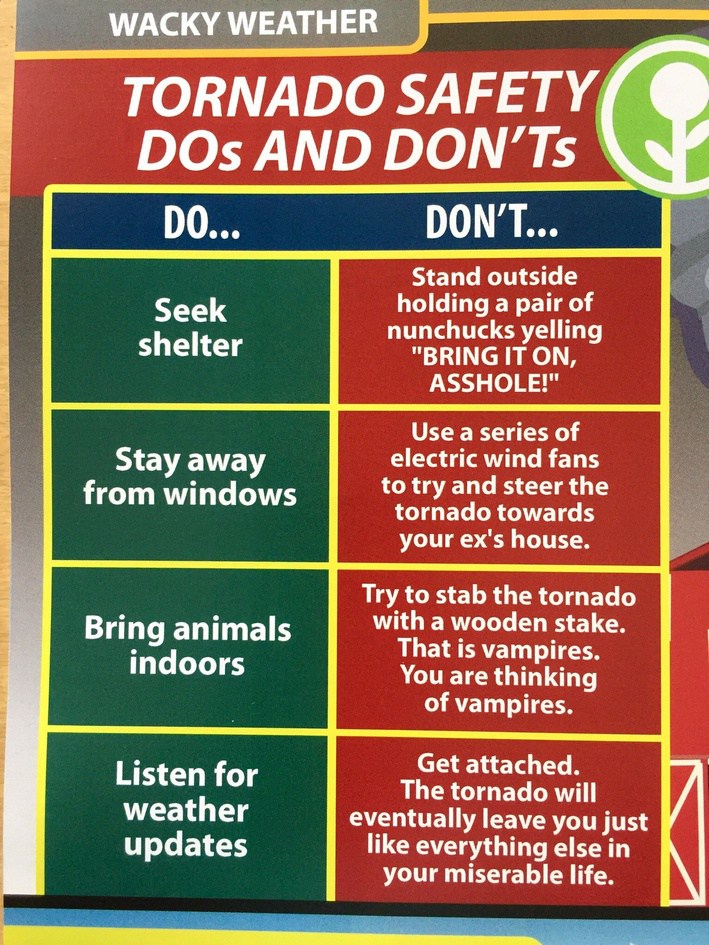
|
Tornadoes are the most violent storms on Earth, with wind velocities that can exceed 200 miles per hour. How do these terrifying cyclones form? Meteorologist James Spann sheds light on the lifespan of tornadoes as they go from supercell thunderstorms to terrible twisters before eventually dissolving back into thin air.
How do tornadoes form? That is pretty easy to answer since there has been a large amount of study into the subject. They are usually the extreme result of a supercell thunderstorm. During the storm cold air and warm air combine in a set pattern: the cold air drops as the warm air rises. The warm air eventually twists into a spiral and forms the funnel cloud that we all associate with a tornado.
The formation of a tornado follows a clear set of steps. First there a change in wind direction and an increase in wind speed. This change occurs at an increasing altitude and creates an invisible horizontal spinning effect in the lower atmosphere. Next, rising air within the thunderstorm’s updraft tilts the rotating air from horizontal to vertical. Third, an area of rotation, 3-10 km wide is contained within a vast majority of the storm. This is where the strongest tornadoes form. Then a lower cloud base in the center of the storm becomes a rotating wall cloud. This area can be nearly rain-free. Lastly, a tornado develops and starts to wreak its destruction.
Once a tornado has formed, it follows a predictable life cycle. First, the mesocyclone(rotating air), along with the rear flank downdraft( RFD), starts moving towards the ground. A small funnel appears to build up at the bottom of a wall cloud. As the RFD reaches the ground, the surrounding dirt rises up, causing damage even to heavy objects. The funnel touches the ground immediately after the RFD, forming a tornado.
During the next stage the tornado’s main source of energy, the RFD, begins to cool. The distance the tornado covers, depends on the rate at which the RFD cools. If the RFD cannot further provide any more warm air to the tornado, it begins to die.
Lastly, with the tornado’s warm air supply cut, the vortex begins to weaken and shrivel away. As the tornado weakens, the mesocyclone also starts to dissipate, but a new mesocyclone can start very close to the dying one. Those are the basics of tornado formation and life.
Night Hawk In Light demonstrates how to make a mini fire tornado in this video.
Enjoy!
This demonstration has been around for a few years now and I figured it was about time I gave it a shot myself. Many have made fire tornado’s using nothing more than a bowl of liquid alcohol for the flame, but I found that to be dangerous as the burning liquid could spill and cause a serious fire. The addition of cotton balls removes the risk of splashing. Care should always be taken around fire to be sure nothing flammable is nearby and that there is proper ventilation. A fire extinguisher should always be within reach whenever performing an experiment like this! Stay safe!

Just when you think you’ve heard everything, some Liberal proves you wrong! 1,000 feet high walls in the mid west of the US? At least move them to the southern border!
Forget the Great Wall of China. How about the Great Wall of … Kansas?
One scientist thinks we can protect parts of the central USA from ferocious tornadoes by building several gigantic walls across Tornado Alley:
“If we build three east-west great walls in the American Midwest …. one in North Dakota, one along the border between Kansas and Oklahoma to the east, and the third one in south Texas and Louisiana, we will diminish the tornado threats in the Tornado Alley forever,” according to physicist Rongjia Tao of Temple University.
The walls would need to be about 1,000 feet high and 150 feet wide, he said.
From Brian Thomas at WAEB radio:
ROTFLMAO. When the enviro-leftists start talking about spending money building infrastructure in anticipation of the effects of global warming, think of this story. Please don’t overlook the opportunity for advertising revenue with billboards adorning the sides of the walls. Laugh away, but don’t you just love the (bird-slaughtering)amber waves of windmills criss-crossing the fruited plains of America? Freaking oil wells in the frozen tundra of Alaska piss me off.